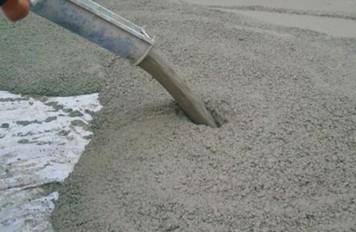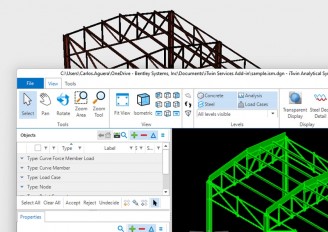Cracks in concrete: A new way to discover a reaction that causes them

Bridges, dams, nuclear plants and other concrete structures are built to stand for decades, but they are not indestructible.
One phenomenon that shortens the life of concrete buildings and structures is the alkali-silica reaction (ASR). It is the reaction between alkali ions found in cement and silica, the two main components of concrete, which creates a gel that absorbs water and expands, causing internal pressures to build up within the concrete.
Over time, this pressure can crack concrete structures and degrade them. There is currently no cure for ASR, and it is both destructive and time-consuming to identify it in existing structures.
To help identify the extent of ASR, researchers at the Argonne National Laboratory have discovered a harmless way to detect it that could reduce the level of expensive testing being done. Their new method relies on electrochemical impedance spectroscopy (EIS), which measures electrical conductivity.
Until now, only way engineers could spot ASR was by taking several core samples and analyzing them under a microscope.
“This detection method is costly, time-consuming and destructive, which is not ideal,” says Argonne scientist Alexander Heifetz.
Heifetz and his research team discovered that EIS can nondestructively detect ASR.
Electricity gets conducted in concrete through networks of pores which form during curing and contain ionic fluids. The gel that forms during ASR spreads to fill the gaps in these networks.
Researchers theorized that ASR affects the ionic fluids within the pores, as well as the connectivity of the pore networks themselves. This, in turn, could change the concrete’s electric conduction, which the researchers could measure using EIS.
Engineers have used EIS to indirectly measure mechanical properties of concrete, such as strength during curing. But the Argonne team are the first to apply this method to detect ASR.
To test its reliability, the team induced accelerated ASR in concrete samples. The team than then measured EIS on the samples and calculated the electrical resistance of concrete from the data.
The team found that ASR changes the concrete’s electrical resistance, creating a signature that scientists could use to distinguish and locate ASR.
“We basically found a way to characterize a material’s property based on its current conduction, and in the end, we found there is correlation between conduction and the presence and progression of ASR,” says Heifetz.
EIS is nondestructive, so using it to monitor ASR could reduce the amount of curing needed to diagnose and monitor high-value concrete structures.
“We have the potential to develop this into a technique for use on structures,” Heifetz said. “We’re now working with industry to see if this approach will work on a greater range of geological samples than those used in our study, to hopefully advance its application.”
Sources: machinedesign.com, anl.gov
Want to read more like this story?
Concrete Structures
Jan, 01, 2019 | EducationConcrete structures are constructions that utilize concrete as the primary building material. Conc...

Concrete that traps CO2 emissions for good
Jul, 16, 2018 | NewsA new method to produce concrete that traps harmful CO2 emissions and increases the compression stre...

Zero-cement concrete will reduce the environmental impact in construction industry
Aug, 08, 2024 | NewsDue to the climate crisis and the high CO2 emissions of concrete, engineers and scientists are seek...

Concrete damage based on 4 crucial factors
Feb, 01, 2024 | NewsConcrete often sustains damage due to various factors, either environmental or mechanical. In the f...
Carrot-shaped Sample Testing of Shotcrete
Jan, 01, 2019 | EducationThe slab of concrete (see picture 1) was brought from the construction site. This sample of concrete...

Fire-damaged concrete structures: how do we know when to fix or rebuild a concrete structure after a fire?
Nov, 15, 2021 | NewsGenerally, when concrete is exposed to intense fire, materials in the concrete can decompose, and c...

Discarded plastic bottles could be used to make stronger concrete
Jan, 15, 2018 | NewsMIT students have found a way to produce plastic-reinforced concrete that is up to 15% stronger than...

Fibers to help fire damage prevention in tunnels
Feb, 25, 2015 | NewsEngineers at the Technical University of Munich (TUM) have come up with a way to prevent concrete sp...

This new construction system allows affordable and easy to build concrete walls of any shape, thickness and size
Aug, 08, 2017 | NewsThe company claims that about half the time or less is needed to erect a residential structure compa...
Trending

Spectacular interchanges around the world

New Release - STAAD.Pro 2024 - 2

ADINA 2025 for Structural WorkSuite

ADINA 2025 New Release!

Concrete Buildings as Rechargeable Batteries

Powerful earthquake shakes central Philippines, dozens killed


